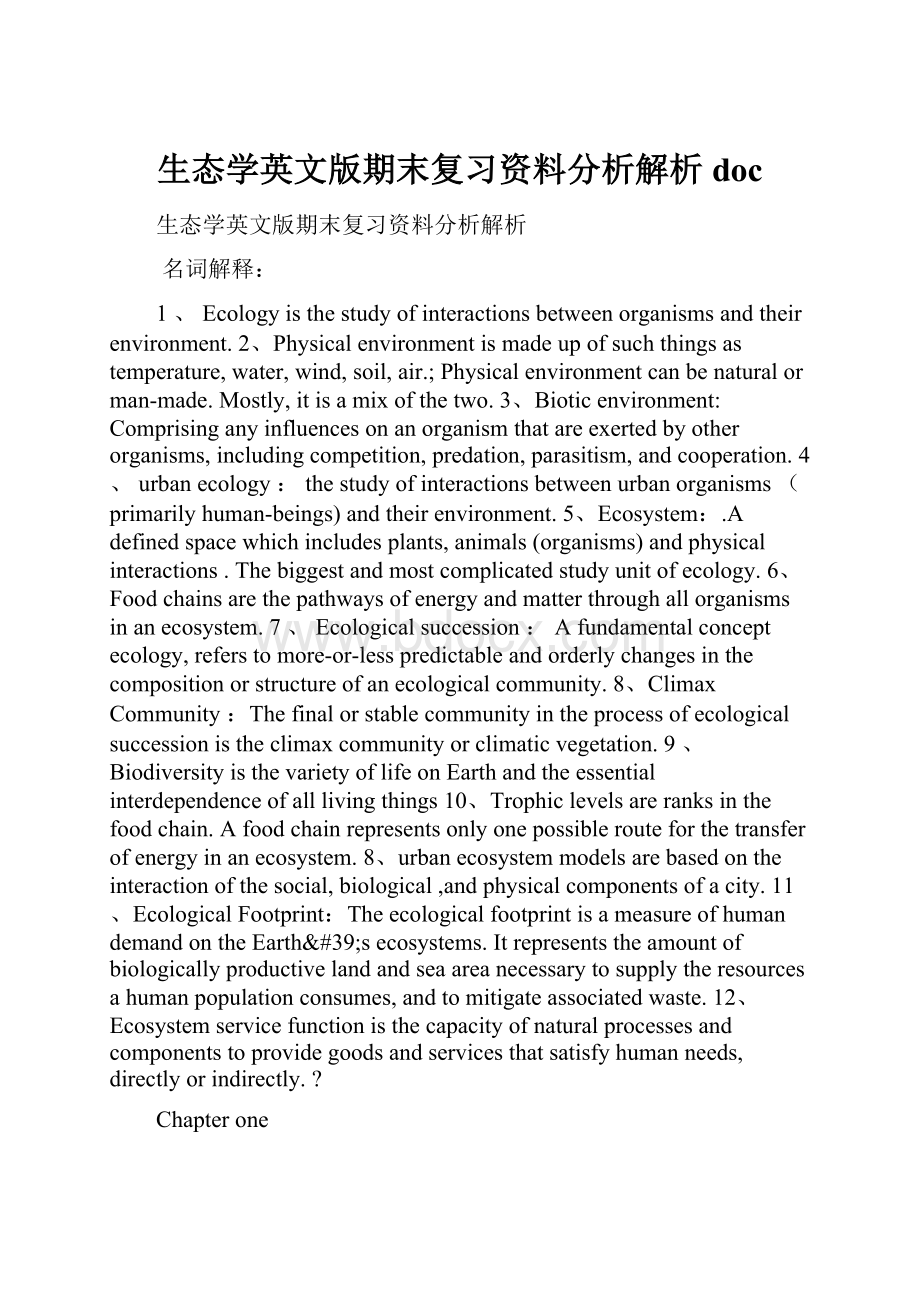生态学英文版期末复习资料分析解析doc.docx
《生态学英文版期末复习资料分析解析doc.docx》由会员分享,可在线阅读,更多相关《生态学英文版期末复习资料分析解析doc.docx(8页珍藏版)》请在冰豆网上搜索。

生态学英文版期末复习资料分析解析doc
生态学英文版期末复习资料分析解析
名词解释:
1、Ecologyisthestudyofinteractionsbetweenorganismsandtheirenvironment.2、Physicalenvironmentismadeupofsuchthingsastemperature,water,wind,soil,air.;Physicalenvironmentcanbenaturalorman-made.Mostly,itisamixofthetwo.3、Bioticenvironment:
Comprisinganyinfluencesonanorganismthatareexertedbyotherorganisms,includingcompetition,predation,parasitism,andcooperation.4、urbanecology:
thestudyofinteractionsbetweenurbanorganisms(primarilyhuman-beings)andtheirenvironment.5、Ecosystem:
.Adefinedspacewhichincludesplants,animals(organisms)andphysicalinteractions.Thebiggestandmostcomplicatedstudyunitofecology.6、Foodchainsarethepathwaysofenergyandmatterthroughallorganismsinanecosystem.7、Ecologicalsuccession:
Afundamentalconceptecology,referstomore-or-lesspredictableandorderlychangesinthecompositionorstructureofanecologicalcommunity.8、ClimaxCommunity:
Thefinalorstablecommunityintheprocessofecologicalsuccessionistheclimaxcommunityorclimaticvegetation.9、BiodiversityisthevarietyoflifeonEarthandtheessentialinterdependenceofalllivingthings10、Trophiclevelsareranksinthefoodchain.Afoodchainrepresentsonlyonepossiblerouteforthetransferofenergyinanecosystem.8、urbanecosystemmodelsarebasedontheinteractionofthesocial,biological,andphysicalcomponentsofacity.11、EcologicalFootprint:
TheecologicalfootprintisameasureofhumandemandontheEarth'secosystems.Itrepresentstheamountofbiologicallyproductivelandandseaareanecessarytosupplytheresourcesahumanpopulationconsumes,andtomitigateassociatedwaste.12、Ecosystemservicefunctionisthecapacityofnaturalprocessesandcomponentstoprovidegoodsandservicesthatsatisfyhumanneeds,directlyorindirectly.?
Chapterone
1、Ecologyisthestudyofinteractionsbetweenorganismsandtheirenvironment.2、Physicalenvironmentismadeupofsuchthingsastemperature,water,wind,soil,air.;Physicalenvironmentcanbenaturalorman-made.Mostly,itisamixofthetwo.3、Bioticenvironment:
Comprisinganyinfluencesonanorganismthatareexertedbyotherorganisms,includingcompetition,predation,parasitism,andcooperation.4、ariousBranchesofEcology_bystudyobjects(研究对象).分子生态学(moleculeecology).个体生态学(autecology).种群生态学(populationecology).群落生态学(communityecology).生态系统生态学(ecosystemecology).景观生态学(landscapeecology).全球生态学(globalecology)5、Sizeofyourstudyinecology.Individuals.Populations.Communities.Ecosystems6、urbanecology:
thestudyofinteractionsbetweenurbanorganisms(primarilyhuman-beings)andtheirenvironment.
Chaptertwo
1、Ecosystem:
.Adefinedspacewhichincludesplants,animals(organisms)andphysicalinteractions.Thebiggestandmostcomplicatedstudyunitofecology..Anecosystemcanbeofanysizedependingonthecommunitiestobestudied..Ecologiststendtothinkofecosystemintermsofenergyflow,carbonflowornutrientcycles.2、太阳辐射能无生命成分无机物质有机物质生态系统生产者(绿色植物)生命成分消费者(动物)还原者(微生物)
3、EnergyFlow
生态系统的能量流动主要由三者构成:
生产者、消费者、分解者。
能量主要来自于太阳,生产者(绿色植物)通过光合作用可以直接吸收太阳中的能量。
初级消费者以绿色植物即生产者为食,此时能量由生产者转移到初级消费者体内;高级消费者如食肉动物等以初级消费者为食,能量因此又发生转移。
消费者或机体部分的死亡以及在生命过程中的排泄再加上初级生产者的死亡,这些死亡的部分大部分归入土壤,被分解者主要是细菌分解成初级消费者可以吸收的营养成分。
4、Foodchainsarethepathwaysofenergyandmatterthroughallorganismsinanecosystem.5、Trophiclevelsareranksinthefoodchain.Afoodchainrepresentsonlyonepossiblerouteforthetransferofenergyinanecosystem.(图)6、circulationofenergy&nutrition(解释三层意思1、有哪几部分组成2、能量在物质间不断循环3、初级的生产者转化到高一级时能量总是要少于初级的能量)
生产者通过光合作用产生了能量,它产生的物质量必须超过初级消费者的能量,初级消费者产生的能量也必须超过次级消费者的能量?
?
以此类推,能量在流动过程中是逐级递减的,只有这样才能保证生态系统的平衡。
而所有的生产者,消费者最终都不免走向死亡,死亡的机体部分由分解者分解,一部分变成热量散发,一部分变成营养物质,被生产者吸收,转化为能量。
于是生态系统得以循环往复。
7、Ecosystemandthelawsofthermodynamics:
Firstlaw:
Energycanneitherbecreatednordestroyed.Secondlaw:
Everytransformationresultsinareductionofthefreeenergyofthesystem.8、Transferefficiency:
Theproportionofenergythatflowsthroughtrophiclevels(营养层)inthewayenergyisusedandpassedfromonesteptothenext..Therearethreecategoriesoftransferefficiency:
ConsumptionEfficiency(CE),AssimilationEfficiency(AE),andProductionEfficiency(PE).9、Nutrientrecycle:
Watercycle.Carboncycle.Nitrogencycle10、碳循环(讨论题):
绿色植物如森林植被通过光合作用吸收大气中的碳,死亡后机体被分解成二氧化碳,热量和营养物质。
夜晚植物也会释放出二氧化碳。
但是,植被吸收的二氧化碳两要超过它所释放的。
海洋也会吸收和排出二氧化碳,但总的来说。
海洋吸收的二氧化碳超过了排出的二氧化碳。
化石能源在燃烧过程中也排放出大量的二氧化碳,其中排出的二氧化碳量超过了植被、海洋的吸收能力,因此二氧化碳的增多主要是人类燃烧化石能源造成的。
Chapter3:
ChangesinEcosystems:
EcologicalSuccession
1.urbanecosystemUrbanecosystemmodelsarebasedontheinteractionofthesocial,biological,andphysicalcomponentsofacity.
Socialenvironment社会环境系统包括人工建造的物质环境系统(包括各类房屋建筑、道桥及运输工具、供电、供能、通风和市政管理设施及娱乐休闲设施等)和非物质环境系统(包括城市经济、文化与群众组织系统,社会服务系统、科学文化教育系统等)(man—madephysicalelementsandnon—physicalelements)Structureofurbanecosystem
2.EcologicalsuccessionAfundamentalconceptecology,referstomore-or-lesspredictableandorderlychangesinthecompositionorstructureofanecologicalcommunity.3.ClimaxCommunityThefinalorstablecommunityintheprocessofecologicalsuccessionistheclimaxcommunityorclimaticvegetation.Itisself-perpetuatingandinequilibriumwiththephysicalhabitat.Thereisnonetannualaccumulationoforganicmatterinaclimaxcommunitymostly.TheannualproductionbalancedinsuchaClimaxCommunity.4.BiodiversityisthevarietyoflifeonEarthandtheessentialinterdependenceofalllivingthings3componentsofbiodiversityDiversityofgenes
DiversityofspeciesVarietyofecosystems5.ThreatstobiodiversityHabitatdestructionPollutionSpeciesintroductionsGlobalclimatechangeExploitation
ChapterFour
UrbanPopulationandEnvironment
一、Populationstructure:
?
?
?
?
?
?
?
1.Agestructure:
young,mid,andold2.Sexstructure:
maleandfemale3.nationalitystructure:
hanandminorities4.HouseholdregistrationStructure:
ruralorurban5.Familystructure:
marriedorsingle6.Education:
high,literateandilliterate7.Employment:
employedandunemployed
二、Agestructureandpopulationgrowth:
Increasing、Stable、Decreasing
三、EcologicalFootprint
TheecologicalfootprintisameasureofhumandemandontheEarth'secosystems.Itrepresentstheamountofbiologicallyproductivelandandseaareanecessarytosupplytheresourcesahumanpopulationconsumes,andtomitigateassociatedwaste.四、中国发展带来的环境问题?
?
?
?
?
?
?
?
?
?
?
?
1.水污染2.大气污染3.固体废弃物污染4.酸雨5.荒漠化6.森林锐减7.资源短缺8.耕地减少9.生物多样性丧失10.臭氧层损耗11.全球气候变化12.持久性有机物污染
五、存在的问题和面临的挑战
1.人均耕地仅(farmlandpercapita)为世界平均水平的33%,荒漠化(desertification)严重,土地被占用,30%耕地有水土流失(soilerosion);?
2.森林覆盖(forestcoverage)面积增加,但成熟林(grown-upforest)比例减少;?
3.水资源短缺,水污染严重(watershortage&pollution);?
4.城市大气质量差(airquality&pollution);?
5.固体废弃物(solidwaste)不断增加,但没有得到安全处理;?
6.生物多样性(bio-diversity)减少;?
7.资源可利用量(usableresources)少,(usageefficiency)低。
六、Whatisecosystemservicefunctions?
Ecosystemservicefunctionisthecapacityofnaturalprocessesandcomponentstoprovidegoodsandservicesthatsatisfyhumanneeds,directlyorindirectly.?
Ecosystemprovidesavarietyofproductsforhumanbeings,andmaintainsthefunctionsoflife-supportsystem七
八、生态服务功能的价值
1.USEVALUES:
⑴Directvalues:
Outputsthatcanbeconsumedorprocesseddirectly,suchastimber,fodder,fuel,non-timberforestproducts,meat,medicines,wildfoods,etc.⑵Indirectvalues:
Ecologicalservices,suchasfloodcontrol,regulationofwaterflowsandsupplies,nutrientretention,climateregulation,etc.⑶Optionvalues:
Premium(价值)placedonmaintainingresourcesandlandscapesforfuturepossibledirectandindirectuses,someofwhichmaynotbeknownnow.2.NON-USEVALUES:
Existencevalues:
Intrinsic(内在)valueofresourcesandlandscapes,irrespectiveofitsusesuchascultural,aesthetic,bequest(遗产)significance,etc.
ChapterFourDirectvalues
Goodsandproducts
UrbanPopulationandEnvironmentMarketPrices(市场价格)
Indirectvalues
Ecosystemservices
Productivity&cost-basedapproaches
(生产法与成本核算法)
EffectonProductionReplacementCostsCostofProvidingSubstitutesCostofAvoidedDamage
Optionvalues
Surrogatemarket&statedpreferenceapproaches
(替代市场和支付意愿法)TravelCostsContingentValuation
ExistencevaluesDirectvalues
Naturetourism
ChapterFiveurbanenvironment----physical城市环境-----物理环境
1、Naturalphysicalenvironment?
①Geologicalenvironment?
②Urbanairsphere?
③Urbanwater?
④UrbanNoise?
⑤UrbanSoil?
⑥Urbanclimate2、HeatIslandEffect城市“热岛效应”是城市气候最明显的特征之一,是指城市气温高于郊区气温的现象。
XX百科:
城市热岛效应是城市气候中典型的特征之一。
它是城市气温比郊区气温高的现象。
城市热岛的形成一方面是在现代化大城市中,人们的日常生活所发出的热量;另一方面,城市中建筑群密集,沥青和水泥路面比郊区的土壤、植被具有更小的函授比热容(可吸收更多的热量),并且反射率小,吸收率大,使得城市白天吸收储存太阳能比郊区多,夜晚城市降温缓慢仍比郊区气温高。
城市热岛是以市中心为热岛中心,有一股较强的暖气流在此上升,而郊外上空为相对冷的空气下沉,这样便形成了城郊环流,空气中的各种污染物在这种局地环流的作用下,聚集在城市上空,如果没有很强的冷空气,城市空气污染将加重,人类生存的环境被破坏,导致人类发生各种疾病,甚至造成死亡。
“热岛效应”的成因气候条件是造成城市热岛效应的外部因素,而城市化才是热岛形成的内因。
一般认为热岛成因有三:
一是城市与郊区地表面性质不同,热力性质差异较大。
城区反射率小,吸收热量多,蒸发耗热少,热量传导较快,而辐射散失热量较慢,郊区恰相反二是城区排放的人为热量比郊区大三是城区大气污染物浓度大,气溶胶微粒多,在一定程度上起了保温作用。
大气污染在城市热岛效应中起着相当复杂特殊的作用。
来自工业生产、交通运输以及日常生活中的大气污染物在城区浓度特别大,它像一张厚厚的毯子覆盖在城市上空,白天它大大地削弱了太阳直接辐射,城区升温减缓,有时可在城市产生“冷岛”效应。
夜间它将大大减少城区地表有效长波辐射所造成的热量损耗,起到保温作用,使城市比郊区“冷却”得慢,形成夜间热岛现象。
防止热岛效应的方法1.选择高效美观的绿化形式、包括街心公园、屋顶绿化和墙壁垂直绿化及水景设置,可有效地降低热岛效应,获得清新宜人的室内外环境。
2.居住区的绿化管理要建立绿化与环境相结合的管理机制并且建立相关的地方性行政法规,以保证绿化用地。
3.要统筹规划公路、高空走廊和街道这些温室气体排放较为密集的地区的绿化,营造绿色通风系统,把市外新鲜空气引进市内,以改善小气候。
4.应把消除裸地、消灭扬尘作为城市管理的重要内容。
除建筑物、硬路面和林木之外,全部地表应为草坪所覆盖,甚至在树冠投影处草坪难以生长的地方,也应用碎玉米秸和锯木小块加以遮蔽,以提高地表的比热容。
5.建设若干条林荫大道,使其构成城区的带状绿色通道,逐步形成以绿色为隔离带的城区组团布局,减弱热岛效应在现有的条件上,应考虑1.控制使用空调器,提高建筑物隔热材料的质量,以减少人工热量的排放;改善市区道路的保水性性能。
2.建筑物淡色化以增加热量的反射。
3.提高能源的利用率,改